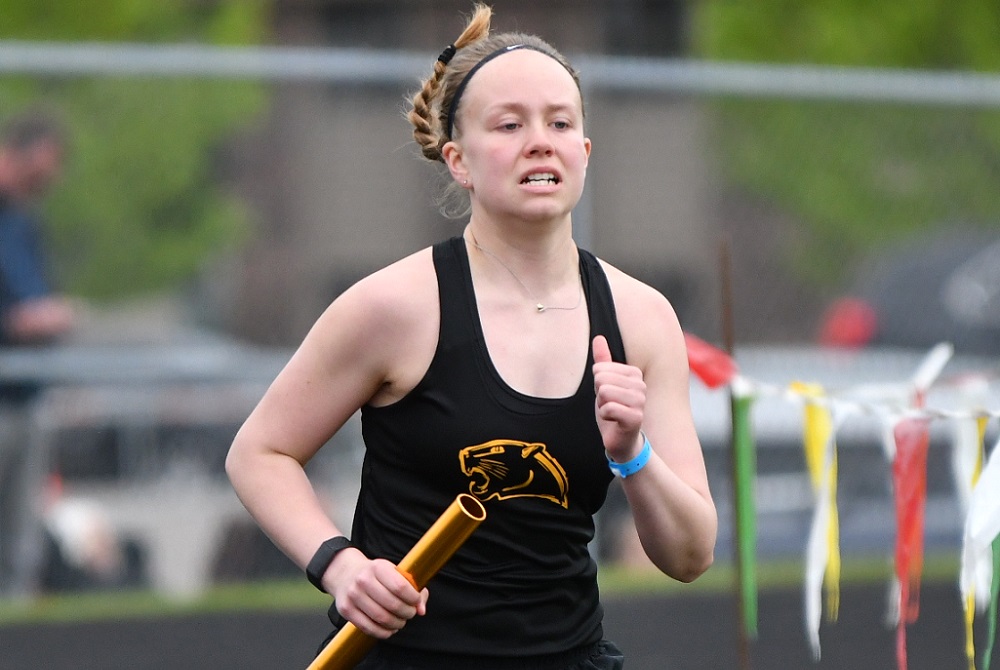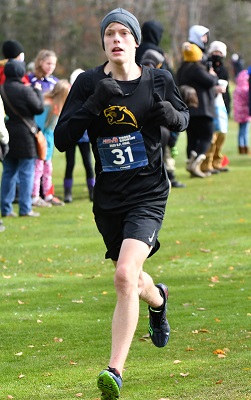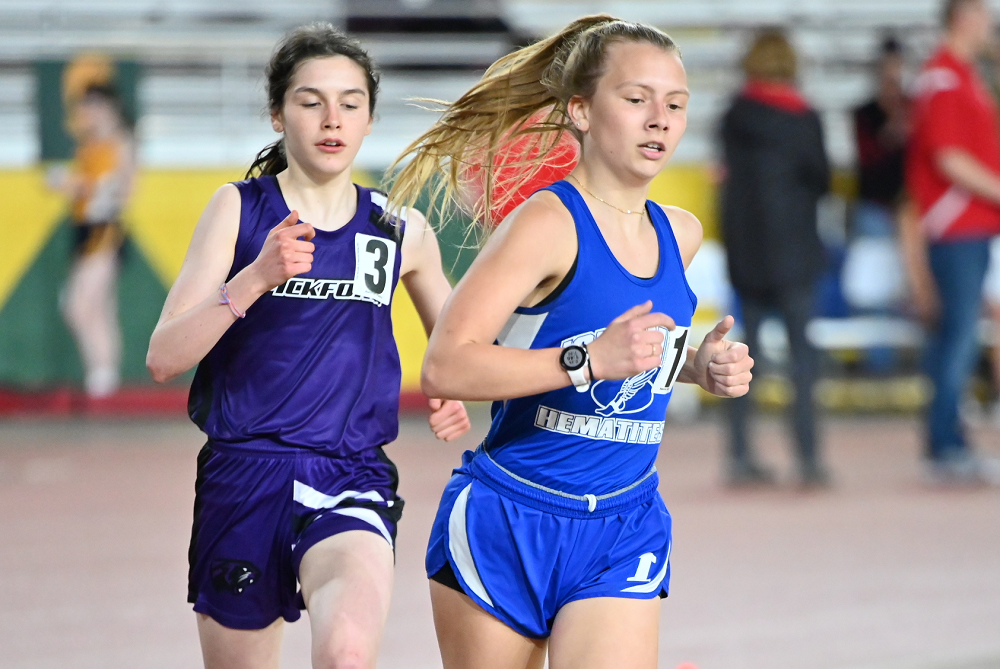
Ewen-Trout Creek Racers Fueled to Go Distance Again
By
John Vrancic
Special for MHSAA.com
May 25, 2021
BARAGA — Elise Besonen wasn’t always a huge fan of distance running.
 Then came 2020 and the COVID-19 pandemic, and the current Ewen-Trout Creek senior had a change of heart.
Then came 2020 and the COVID-19 pandemic, and the current Ewen-Trout Creek senior had a change of heart.
The University of Wisconsin-Superior basketball recruit now says she enjoys running.
Maybe there’s some truth to the saying “Absence makes the heart grow fonder.”
“I was pretty bummed when we didn’t get to run last year,” she said shortly after placing second in the 3,200-meter run at 13 minutes, 33.68 seconds in the Upper Peninsula Division 3 Regional meet last Wednesday at Baraga. “Then, I started running on some side roads with my dad, and it completely changed my mindset. It has been fun running for my dad. In my freshman year during driver’s ed, it was just us two. I guess it was sort of a blessing in disguise.”
Besonen was also runner-up in the 800 (2:40.21) and 1,600 (5:43.59) at the Regional, qualifying her for all three races at the Upper Peninsula Finals on June 5 at Kingsford.
“It was a pretty short meet,” said Besonen, who was also runner-up in the 800 at the previous Monday’s Copper Country Invitational in Houghton in a school-record 2:32.81. “The 800 and 3,200 were pretty close together, which made it pretty difficult because they were right on top of each other. At least my legs were warmed up.”
 Junior Jonah Nordine hadn’t run in nearly a week following a mishap during homecoming activities at the school two weeks ago.
Junior Jonah Nordine hadn’t run in nearly a week following a mishap during homecoming activities at the school two weeks ago.
“I fell off a bike and scraped up my knee and arm,” he said. “We usually have homecoming for basketball, but that got postponed due to COVID and (we) held it during baseball and track this year.”
Nordine, the reigning U.P. Division 3 cross country champion, won the 800, 1,600 and 3,200 in the Marcy Bracket Invitational at Bessemer on May 13, then was runner-up in the 800 (2:16.48) and 1,600 (4:40.27) and third in the 3,200 (11:28.33) at Baraga.
“I had a side ache in the 3,200,” he said. “I probably didn’t eat enough (that day). I was pretty happy with my times. I just wanted to qualify. We had perfect conditions at Bessemer. I didn’t run in Houghton, but it was quite warm. It was in the 80s. I’m just glad to be running this year after losing my freshman season to COVID.”
“Jonah’s success generates a lot of excitement for this team," added Ewen-Trout Creek track and cross country coach Brad Besonen, who also is Elise’s father. “Jonah’s personality changed after his success in cross country last fall. He has become more outgoing.”
Elise is best-known as a high-scoring guard who made the Division 4 all-state basketball team again this winter and was named Upper Peninsula Division 4 Player of the Year in the sport.
She figures to continue playing point guard for Wisconsin-Superior, another chase she’ll take on when her track season is done.
“There will be a lot of adjustments to make,” she said. “Everybody wants to be there, and I’m looking forward to that.”
 John Vrancic has covered high school sports in the Upper Peninsula since joining the Escanaba Daily Press staff in 1985. He is known most prominently across the peninsula for his extensive coverage of cross country and track & field that frequently appears in newspapers from the Wisconsin border to Lake Huron. He received the James Trethewey Award for Distinguished Service in 2015 from the Upper Peninsula Sportswriters and Sportscasters Association.
John Vrancic has covered high school sports in the Upper Peninsula since joining the Escanaba Daily Press staff in 1985. He is known most prominently across the peninsula for his extensive coverage of cross country and track & field that frequently appears in newspapers from the Wisconsin border to Lake Huron. He received the James Trethewey Award for Distinguished Service in 2015 from the Upper Peninsula Sportswriters and Sportscasters Association.
PHOTOS: (Top) Ewen-Trout Creek’s Elise Besonen completes her anchor leg of the 3,200 relay during the UP Division 3 Finals in 2019. (Middle) Jonah Nordine crosses the finish line first at last fall’s UPD3 Boys Cross Country Final. (Photos by Cara Kamps.)

Preview: Super Seniors Set to Celebrate Big Finishes at UP Girls Finals
By
Geoff Kimmerly
MHSAA.com senior editor
June 2, 2023
The baton will be passed literally and figuratively several times during the Upper Peninsula Girls Track & Field Finals on Saturday.
Fans will watch the final competitions for a number of accomplished seniors, particularly Marquette’s Baux Truckey as she attempts to add to an impressive career championship haul.
They’ll also cheer on standouts like West Iron County junior Danica Shamion, Ishpeming junior Lola Korpi and Lake Linden-Hubbell sophomore Emily Jokela as they continue their historic rises.
All three divisions will again be contested at Kingsford High School, with preliminaries leading off the day at 9 a.m. local (Central) time. Tickets cost $11 and are available digitally only via GoFan.
MHSAA.tv will live-stream the meets beginning at 9 a.m. (CDT)/10 a.m. (EDT), viewable with subscription.
Following is a glance at team contenders and individuals to watch in all three divisions:
Division 1
Team forecast: Negaunee and Marquette both have won two of the last four championships, the Miners finishing first last season by 21½ points. They competed at separate Regionals two weeks ago, both winning those meets, and appear to be the favorites again – although Houghton and Sault Ste. Marie, the runners-up at those Regionals, have the potential to challenge at the top. Just as Negaunee got big contributions from freshmen last season, Marquette could do the same this time – although both also will say good-bye to accomplished seniors as well.
Claire Filpus, Houghton senior: Last year’s 1,600 champion also was on a relay winner and finished eighth in the 300 hurdles. She’ll run on two contending relays and the 1,600 again, and her 800 time of 2:37.70 was fourth-fastest among both UPD1 Regionals.
Cassandra Gallagher, Sault Ste. Marie senior: She finished first in the 3,200 and fourth in the 1,600 last season, and she returns after running the fourth-fastest 3,200 (12:50.71) and 1,600 (5:49.04) at UPD1 Regionals.
Aubrey Johnson, Negaunee sophomore: The reigning 800 champion also was a key relay contributor to last year’s team title winner, and she could provide some valuable points elsewhere this time entering with the third-fastest UPD1 Regional time in the 800 (2:37.32) and also with a pole vault (9-0) that tied for second-highest between the two sites.
Eliana Juchemich, Negaunee senior: She finished first in shot put and fourth in discus last season but heads into Saturday with the top UPD1 Regional tosses in both at 35-10¼ and 111-4, respectively.
Erika Malone, Kingsford senior: She won long jump by eight inches last season and was fifth in the 100, and she’s slated to run on two contending relays in addition to her repeat attempt.
Madison Pekrul, Negaunee sophomore: Her Finals debut last season also played a major role in the Miners’ title quest as she won the 100 hurdles and finished second in the 300. She ran the fastest UPD1 Regional time in the 100 hurdles (17.27) two weeks ago and the second-fastest in the 300 (50.74), and she’ll also compete on the favored 1,600 relay.
Faith Spiroff, Ishpeming Westwood sophomore: Last season’s high jump champion and fourth-place finisher in the 200 as just a freshman as well, she’ll enter the weekend after tying for the third-best high jump (5-0) at UPD1 Regionals, the second-best long jump (15-9½), and posting the fifth-best 100 and 200 times.
Baux Truckey, Marquette senior: She’s won the 100 and 200 the last two seasons and may add three more titles after running the fastest 100 (12.88) and 400 (1:04.09) and third-fastest 200 (26.79) at UPD1 Regionals. She’s also run on four relay champions over her career.
Division 2
Team forecast: Bark River-Harris was one of the top stories of last year’s Finals winning its first team championship, and the Broncos won their Regional two weeks ago just ahead of Manistique, while Ishpeming won the other Regional by an even closer margin over West Iron County. When considered together, Bark River-Harris’ depth and Ishpeming’s star power appear to be the main factors in this meet, although the Emeralds could play an interesting role with plenty of contenders.
Mckenzie Hoffmeyer, Bark River-Harris junior: She was a major scorer as BR-H won that first team title last spring, winning long jump, finishing second in the 100 and 200 and running on a first-place relay. Saturday’s schedule sees her on at least one relay but also entering with the top UPD2 Regional long jump (15-5) and third-fastest 100 (13.41) and 200 (27.92).
Lola Korpi, Ishpeming junior: Korpi has won the 800, 1600 and 3,200 the last two seasons. She’ll enter with the fastest UPD2 Regional times in the 800 (2:37.82) and 1,600 (5:25.79) and second-fastest in the 3,200 (12:48.12).
Danielle Lund, Manistique junior: The reigning shot put champion also was second in the discus and ran on the winning 1,600 relay last season, and she could run two relays this time while also entering with the second-farthest shot put (33-1½) and discus (92-8) tosses from UPD2 Regionals.
Lena Pleaugh, Gwinn senior: The reigning 100 hurdles champion also was fourth in long jump and seventh in the 200 last season, and she’ll look to repeat in the 100 hurdles with the second-fastest UPD2 Regional time (17.49) plus contend in the 300 hurdles after running the fastest (52.27) two weeks ago. She also was fourth-fastest in the 100 (13.47) at UPD2 Regionals.
Kadence Potoczak, Pickford senior: She threw the longest discus toss (94-0) and fourth-farthest shot put (30-6) at UPD2 Regionals after winning discus and finishing fourth in shot put at the UPD3 Final last year.
Danica Shamion, West Iron County junior: Shamion also is a six-time individual winner with titles in the 100, 200 and 400 the last two seasons. And she could join the elite four-champion club Saturday as she enters after running the fastest 100 (13.06), 200 (27.11) and 400 (1:00.69) at UPD2 Regionals, plus tying for the top high jump (5-0).
Carley Varoni, Bark River-Harris senior: She won the pole vault by six inches last season and posted the second-highest vault at UPD2 Regionals (8-0) two weeks ago – plus she could run on three relays after running on two a year ago.
Division 3
Team forecast: Ontonagon has won the last two Division 3 championships, last season by 12 points ahead of Stephenson. The Gladiators are loaded in relays and have sprint speed to win again, but Stephenson has similar strengths and qualifiers all over the field events. Newberry and Munising could counter with plenty of scoring in distance events as well.
Kaylen Clark, Newberry junior: The UPD3 cross country runner-up in the fall enters this weekend with the top UPD3 Regional times in the 1,600 (5:47.86) and 3,200 (12:37.24). She finished second in both in UPD2 last season.
Abi Codere, Lake Linden-Hubbell junior: She won the 100 hurdles and was second in pole vault last season, and is looking at possible titles in both with the second-fastest UPD3 Regional time in the 100 hurdles (17.27) and the top pole vault (9-6) by a foot.
Grace Hill, Brimley senior: The reigning shot put champ and discus runner-up threw the top shot (31-5¼) at UPD3 Regionals and the third-farthest discus toss (98-4).
Emily Jokela, Lake Linden-Hubbell sophomore: She made her Finals debut with wins in the 200, 400 and 300 hurdles and a third place in the 100 dash, and she’ll build on that entering this weekend with the fastest UPD3 Regional times in all four – the 100 (13.30), 200 (27.23), 400 (1:01.52) and 300 hurdles (47.22).
Nora Keranen, Dollar Bay sophomore: She won the long jump as a freshman and also finished eighth in the high jump and pole vault, and will return after tying for the top high jump height (4-10) and third-best pole vault (7-6) at UPD3 Regionals.
Jada Kuntze, Stephenson junior: She also tied for the top high jump height (4-10) at UPD3 Regionals and ran the third-fastest 800 (2:36.95) as she looks to add to last season’s championship in the high jump and runner-up finishes in the 800 and 1,600 relay.
PHOTO Ishpeming's Lola Korpi, right, leads the 800 run during the April 17 Superior Dome Invitational, followed closely by Pickford's Talya Schreiber. (Photo by Cara Kamps.)

